History of Fashion 1920s – 1930s
History of Fashion 1920s – 1930s
‘Fashion is not something that exists in dresses only. Fashion is in the sky, in the street, fashion has to do with ideas, the way we live, what is happening’
Coco Chanel
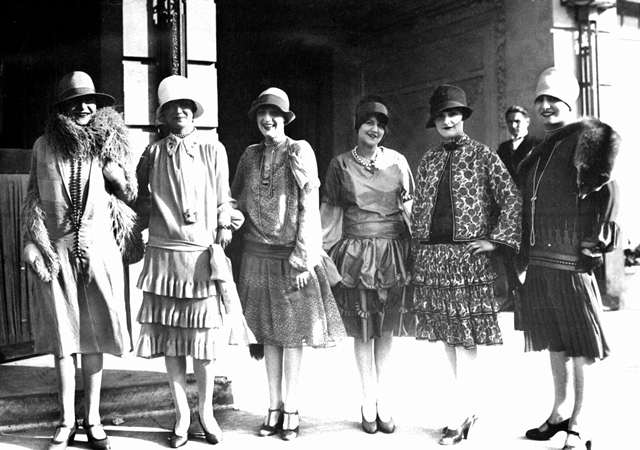
Copyright © AFP/Collection Roger-Viollet – Concours d’élégance en 1925
The Twenties
The decade of the 1920s was an era of vast change; women shocked their men as the hemlines gradually rose, reaching the predominantly mid twenties flapper style. The American dream dominated an age rich in entertainment, full of crime and prohibition. Makeup became popular and the hairstyles became shorter. The notorious flapper girl is known by all and the short sleek hair, above the knee straight shift dress and the boyish figure will never fail to be remembered.
Art and Culture
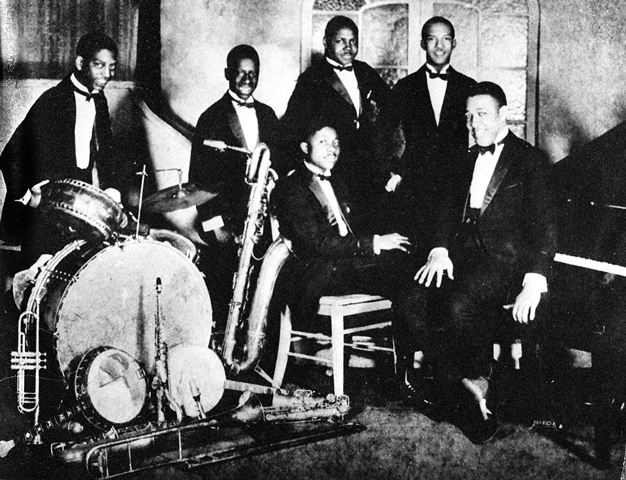
Copyright © AFP/Harlingue/Collection Roger-Viollet – The “Duke Ellington’s Washingtonians 1925
The 1920s is also known as the Jazz era. With the music industry just beginning the likes of Louis Armstrong and Duke Ellington were hugely popular. Art changed with the start of the Art Deco influence. This was seen through stain glass windows all the way to architecture. Famous architects include Frank Lloyd Wright and the design company Bauhaus who structured buildings and interiors with linear lines. The Art Deco influences gave clear inspiration to twenties fashion: the structured lines, squares and pyramid shapes from the architecture can be clearly identified in the style of the short, drop shouldered dresses popular for the period.
Lady Elizabeth Bowes Lyon also known as Queen Elizabeth, The Queen Mother, married the Duke of York on January 13th 1923. Her wedding dress was in style with the twenties fashion of a straight and shapeless dress. The simplistic dress was designed by Madame Handley Seymour who was a former dressmaker to Queen Mary. Through her consistent public appearances she became known as “The Smiling Duchess” due to her unfailing appearance.
The Prohibition
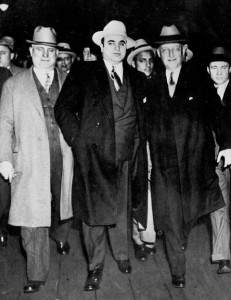
Copyright © AFP/Collection Roger-Viollet – Al Capone
The twenties saw the start of the prohibition period. The manufacture, transport, sale, import and export of alcohol was made illegal in the United States of America. The idea the prohibition would lower crime, lower taxes, reduce social problems and improve health, failed dramatically as organized crime peaked and corruption became the norm. With the ban on alcohol, private, underground establishments called speakeasies were created where alcohol was served illegally. With the rise of prohibition came bootlegging (smuggling) and organized crime. At the height of this Al Capone was notorious for such activities. Dedicated to smuggling liquor and other illegal activities such as prostitution in Chicago, Capone became a public figure during the twenties. Feared and respected Al Capone was seen wearing expensive suits. Double breasted jackets in dark colours with pinstripe or herringbone patterns created an extravagant appearance. Suspenders, fedora hats, two tone shoes and cufflinks, rings and watches created the grand appearance he was known for.
The Flapper Style
Women’s fashion changed dramatically in the twenties. The iconic flapper style didn’t debut until 1926. The androgynous, masculine look was the complete opposite of the previous ladylike demure from the 1900 and 1910s. With genders bending, ‘boyish bob’ and the ‘garconne frock’ were staple fashion phrases. The classic flapper girl wore a short shapeless shift dress, short sleek hair and had an exceedingly flat chest. The flapper demonstrated her rebellious style by wearing makeup and playfully applying it in public. She was seen brandishing cigarette holders and exposing her limbs while dancing unrestrictedly in jazz clubs.
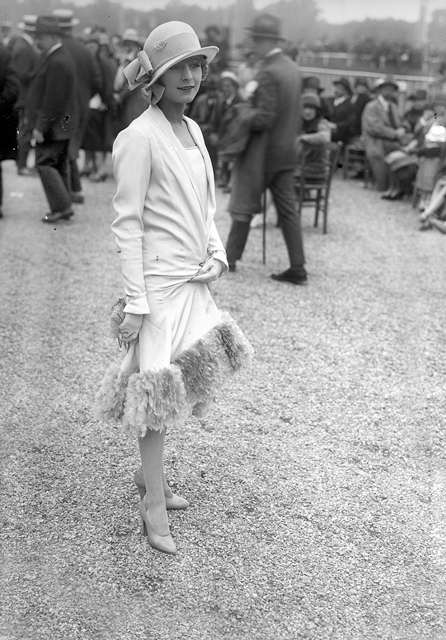
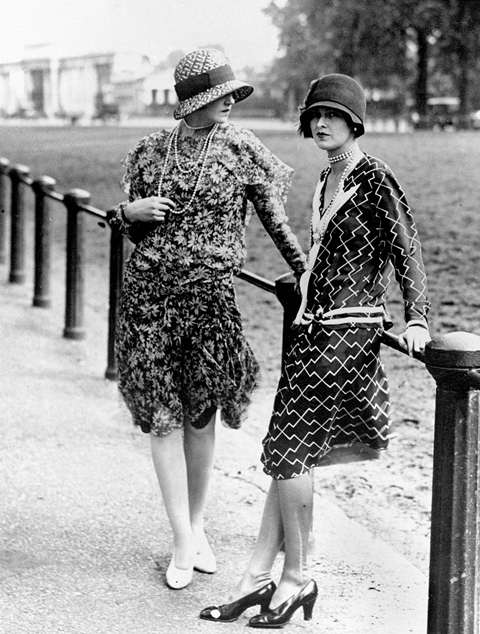
Copyright © AFP/Collection Roger-Viollet – La Mode de Ascot (UK) – 1925
Shapes and Silhouettes
A more sleek and sophisticated look was adopted in the 1920s. Thin spaghetti straps were worn to create a revealing and sexy look. The shift style drop dress was worn by flappers. With no waist, the dress was relatively easy to make at home, allowing the middle class women to blend in with the highly fashionable upper class. The chemise style dress was also worn, usually adorned for dancing to jazz. With the waist disappearing and the bust suppressed a narrow boyish silhouette was preferred. The hair got shorter, curves were eliminated and the line became more simplified.
Menswear
Menswear during the twenties was classic. Suiting was key and with the rise of department stores and catalogues the suit wasn’t just for the city, it became popularized in rural areas too encouraged by the idea of the American dream. During the beginning of the twenties the Conservative Suit was popular. Recognized by its jacket; fitted tightly with a high waist and narrow shoulders, the suit created a thin silhouette. Similarly the Jazz Suit was also fashionable with the Jazz music enthusiasts. Skinny trousers and jackets were worn with pinched in waists and small lapels. Oxford Bags were a trend formed at Oxford University in England after a ban on knickerbockers and plus fours. Wide legged trousers were worn in order to hide the knickerbockers underneath.This practicality then developed into a fashion trend. During the decade short suit jackets were worn, leaving the long jackets seen on morning suits and tail coats for formal occasions. However in the later part of the twenties men started to wear the shorter tuxedo jacket compared to the old tailcoat which was seen as old fashioned. Fedora hats were dominant during the twenties. Originally designed for women, the hat became a male trend when gangsters embraced the accessory. Patent leather brogues were worn with formal wear as were two tone spectators – the classic outfit seen on Al Capone.
Accessories
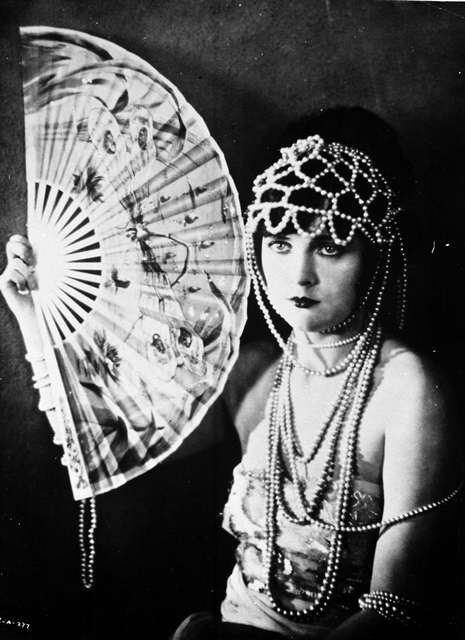
Copyright © AFP / Harlingue / Roger-Viollet
Accessories were a key part of the 1920s look. The accessories were extravagant, big and opulent. Taken from the art deco and Egyptian style, beaded bags, feather boas and embellished head bands were the accessory of choice for evening. Pearls were a staple accessory encouraged by the designer Coco Chanel. Her simplistic outfits were always seen dressed up with strings of pearls. Women were now been seen smoking in public making cigarette holders and cases an added statement of good style. At the beginning of the twenties women’s shoes still had a pointed toe but were gradually becoming more rounded. Around the mid Twenties the Cuban style and Mary Jane style of shoe gained increasing popularity. The shoes were seen as ‘high heels’ for the era, however, only reaching around two inches. Hats were a popular women’s accessory during this period. They created a simple and elegant look. In the early part of the decade simple hats with brims were worn, later on the rimless cloche hat became fashionable mid twenties. The hat was only wearable with a short and flat hairstyle due to the close fitting design. With the hat pulled over the eyes, the style effected ladies posture as it was necessary for them to tilt their heads upwards in order to see.
The Icons
With the introduction of the ‘talkies’ and the decline of the silent movies, the new ‘talking’ film stars became the publics icons. Seen as the ‘it’ girl, Clara Bow was the premiere flapper girl. As a leading sex symbol she epitomized the Twenties style. Josephine Baker became the first African American film star and Greta Garbo was a huge Hollywood film star who retired at 36. A singer and an actor Marlene Dietrich was the highest paid actress of the era and like Dietrich all these women embodied the Twenties look enabling them to become icons of the era.
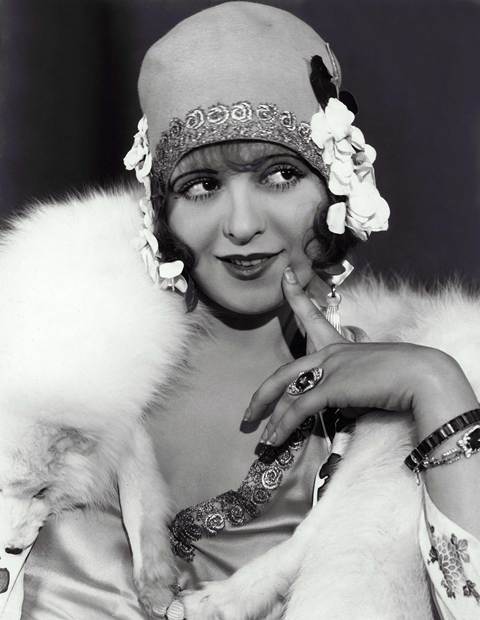
Copyright © AFP / Paramount / The Kobal Collection – Clara Bow
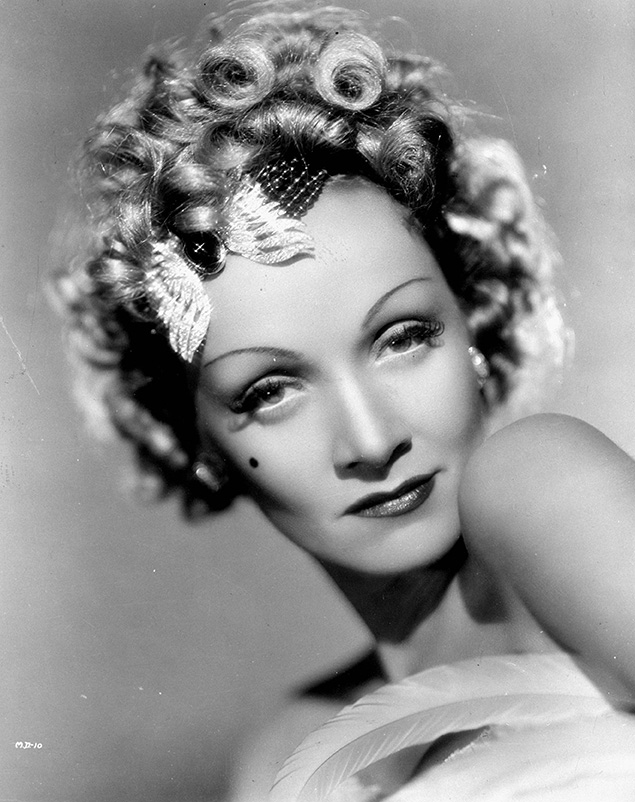
Copyright © AFP / Collection Roger-Viollet – Marlene Dietrich
The Designers
One of the most famous designers known helped to define the silhouette of the 1920 style. Chanel’s Twenties style was not about showing wealth and status but demonstrating elegance and sophistication. She promoted the styles associated with flappers and the pearls to match. Working in basic colours of black, navy, cream and white, she used soft jersey fabrics that did not define the waist. Revolutionary for her time, her clothes were made more for ease of wear. Chanel also designed the first little black dress which has been reinterpreted countless times by many famous designers.
Opening a couture house selling mother/daughter garments, the peak of Lanvin’s popularity hit in the Twenties. Her style adopted the look of the time with the use of embellishment, complex trimmings and exceptional embroideries. In 1926 a menswear range was launched by the designer creating her into the first couturier to dress the whole family. Her designs were easily recognized via her skilful embroidery which was a key attribute to the Twenties style.
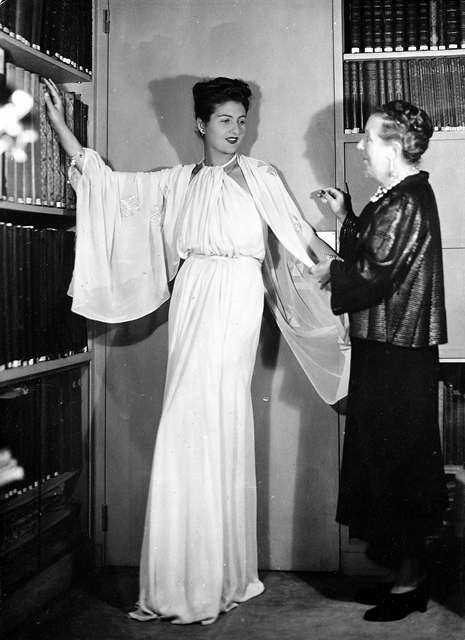
Copyright © AFP / Harlingue / Roger-Viollet – Jeanne Lanvin 1929
Retail
Neiman Marcus
Originally opening in 1907, Neiman Marcus was a high-end department store in Texas. With initial success via wealthy oil-rich customers, the shop saw a rise to power in 1927 after expanding and premiering the first weekly retail fashion show in the United States. Expanding again in 1929, Neiman Marcus started selling Menswear. Neiman Marcus is still a successful luxury department store in Texas, competing against other luxury store including Saks Fifth Avenue, Barneys and Bloomingdales.
Saks Fifth Avenue
Another luxury, specialty store, Saks Fifth Avenue was originally founded in 1867. After the company merged with Gimbel Brothers Inc, Saks Fifth Avenue was opened in 1924 in New York City. With the company aspiring to become national, the twenties saw a rise in Saks Fifth Avenue with a resort store opening in Southampton in 1928. Following this another store opened in Chicago in 1929, followed by another resort store in Miami Beach, Florida. With national domination the chain carried on growing throughout the previous decades and is now a shopping destination spot carrying luxury goods.
Movies
The twenties inspired modern day audiences, with films including ‘The Untouchables’. The 1987 film was based upon Al Capone and the prohibition era and the classic gangster wardrobe was designed by Giorgio Armani.
History of Fashion 1920s – 1930s


Great!
This article was so so so amazing that I want to go on it every time. It inspired me to make dresses, clothing, tuxedo, and more. The only thing is, can you have more pics, everything in the article is boring without a lot of pics.
boii
I’ve learn several good stuff here. Certainly value bookmarking for revisiting. I wonder how so much effort you place to create this sort of fantastic informative website.
awsome
Thanks for answering all of my 1920 fashion questions and more!
all the women are so beautiful during this time period. Its amazing!
OMG! THIS SITE IS AMAZE!
Thank you, this article was amazing!
I enjoy seeing a bit of history of the fashion of the 20s
I really like this website I learn a lot of things about the 1920’s fashion. I’m doing a project and this helped a lot.
I really like this website I learn a lot of things about the 1920’s fashion. I’m doing a project and this helped a lot.
Thanks for answering all of my 1920 fashion questions and more! I enjoy seeing a bit of history of the fashion of the 20s. Thank you, this article was amazing! I really like this website I learn a lot of things about the 1920’s fashion. I’m doing a project and this helped a lot. You are AMAZING !!!!!!!!!!!!!!!!!!!!!! eeeeeeeeeee.
this was so helpfull on my school work. thank you soooo much i cant thank you enough
05.08.2016
Thanks for the helpful info
The 1930s era is one of my favorites. I love the fashion of women and me. It is very classy even down to them dressing casual.
This article was very informative.
yeah
Do you have anything of fashion for women in 1914 to 1929